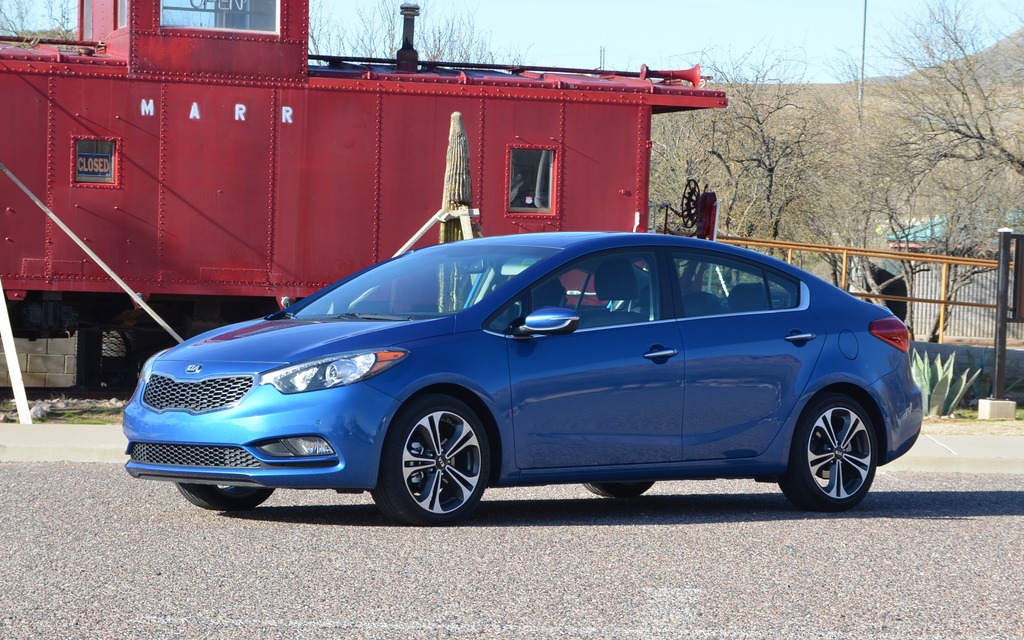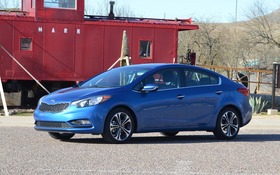2014 Kia Forte: It has what it takes

| Strong points |
|
|---|---|
| Weak points |
|
The Kia Forte was unveiled in 2009 as a 2010 model to replace the lifeless Spectra, but it never achieved the success that Kia was hoping for. In 2012, for example, it was outdone by its cousin/rival, the Hyundai Elantra. Indeed, the Elantra sold 50,950 units in Canada while the Forte had a rather weak showing with only 14,856 cars sold. In Kia’s defense, however, the 2012 Elantra was a brand new car and that year’s Forte belonged to the old generation. Also note, for comparison’s sake, that the bestselling compact, the Honda Civic, sold 64,962 units over the same period.
The previous Forte was very attractive. To be honest, I found that it was pretty cool, at least from a visual standpoint. However, after attending the launch of the very dynamic latest generation, I must admit that it looks a tad outdated. The lights and roof line in the back constitute the two major changes. There are a bunch of other, less significant changes as well.
Pitch black
The designers were extremely imaginative with the dashboard too. The gauges are backlit and are easy to consult, at least during the day (I didn’t test drive the car at night). In the middle, there’s a very handy screen with which you can manage more settings than in an Apollo spacecraft. In front of the passenger, there are three curved bands on the dashboard that, in my humble but always fair (?) opinion, is nicer in person than in photos. Several plastics that would ordinarily be piano black or wood texture are covered with imitation carbon fibre. It’s nice without looking too “MACtac”. But, holy smokes, is the passenger compartment ever black! I wouldn’t be surprised if one day Kia offers a brushed aluminum option. As big as the interior is for the category, the ubiquitous black is suffocating. Oh, and when the sun shows up, there’s a good chance that instead of brightening up the passenger compartment, it will just hit the center screen and make it unreadable.
As was the case for the previous generation, the Forte shares its chassis with the Hyundai Elantra. However, the relation between the two cousins isn’t obvious to the untrained eye, especially since the beltline (the junction between the doors and the side windows) is different.
Three trim levels are offered. There’s the basic LX, the EX and finally, the SX. You can consider yourself very perceptive of you if you noticed that these are the same names as for the previous generation. During the launch of the Forte in Arizona last week, I was only able to drive the SX, the more generous (translation: expensive) version. And, as you’d expect from the Korean manufacturer, the SX’s equipment list is something like the stock at Toys R Us: refrigerated glove compartment, heated and air conditioned driver’s seat, heated rear seats, navigation system, dual-zone climate control and so on.
Kia Forte AJ edition
The less expensive versions are also very well equipped but, strangely, the base version is very, very basic. An LX with a manual transmission, for example, doesn’t even offer air conditioning. For that, you have to go for the automatic. During the interminable conference that preceded our test drive, this news prompted A.J., a colleague from another internet site (obviously not as good as the one you’re currently reading), to exclaim that this model has no chance of being sold. Believe it or not, at supper one of the Kia directors came over to A.J. (no, it wasn’t race car driver A.J. Foyt) to let him know that the company will offer air conditioning on its manual base models by the end of this year. Now that’s a company that knows how to listen and react!
Kia didn’t bother bringing a manual version to the launch. But even with air conditioning, I’d be surprised if it sells more than 5%. So, we test drove an EX loaded to the hilt, which was pleasant all around. My first impression? Solid. No cracking, no suspicious vibrations, well anchored suspensions and a feeling of control. I was a little surprised to find that the seats were comfortable since Koreans seats and my body are rarely compatible.
In addition to being height-adjustable and telescopic, the steering also offers adjustable firmness thanks to a system called Flex Steering (previously seen at Hyundai). And, as at Hyundai, this system is not very convincing. Even in Sport mode, the steering is decent at best. In Comfort mode, you have to constantly fiddle with the steering wheel to keep a straight line, which reminded me of an old Massey-Ferguson I drove one summer when I was twelve. Since the leather on the steering wheel was very slippery, it goes without saying that the experience left a lot to be desired.
Despite very ordinary tires (Nexen CP 671), the passenger compartment is quiet and the handling is very good. The front strut and rear torsion bar suspensions do an excellent job containing both vertical and lateral movement. However, I have to admit that while the curvaceous Arizona roads put the handling to the test, their smooth surfaces would make even a Lotus Exige comfortable.
Did someone say engine?
The base version (LX) gets a 1.8-litre four-cylinder with 148 horsepower and 131 lbs.-ft. of torque. This is the same engine found in the Hyundai Elantra and it offers decent performances, no more, no less. Where the Forte distances itself from its infamous cousin is when it comes to the engines in the EX and SX. We’re talking 2.0 litres, 173 horsepower and 154 lbs.-ft. of torque. This engine replaces the 2.4-litre.
Sure, the 2.0-litre is powerful, but even in flat-out acceleration I didn’t feel the 173 horses. It accelerates quickly, yes, but you won’t be blown away. Fortunately, the engine shriek that characterized the old generation was nowhere to be heard either. Note that the torque effect in the front wheels is very well controlled. The automatic transmission works very well but isn’t transcendent. Its Manual mode – it doesn’t offer shifters behind the steering wheel – is okay, although the novelty wears off quickly.
The new Forte is a lot more mature than before and there’s no doubt that sales will increase. Moreover, coupe and hatchback versions will soon be added to the line-up. But before we can make a conclusive judgement on this vehicle, we’ll have to test it in Canada. This much is certain: the 2014 Kia Forte is an improvement on the previous version.











